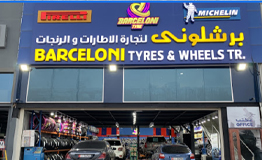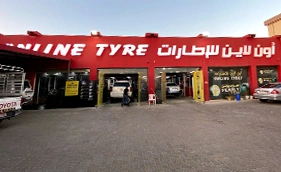How to Prepare Your Tyres for Off-Road Adventures
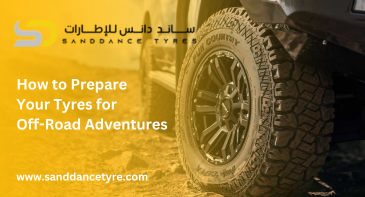
Home > We are here to provide 100% services to our customer How to Prepare Your Tyres for Off-Road Adventures When it comes to off-road adventures, your vehicle’s tyres play a crucial role in ensuring a safe and thrilling experience. Off-road terrains can be unpredictable, ranging from rocky trails to sandy dunes, making it essential to equip your vehicle with the right off-road tyres and prepare them adequately before hitting the trails. In this comprehensive guide, we’ll discuss how to get your tyres ready for any off-road journey while enhancing safety, performance, and adventure. Choosing the Right Off-Road Tyres The first step in preparing for off-road adventures is selecting the right off-road tyres for your vehicle. Not all tyres are built the same, and different terrains require specific types of tyres for optimal performance. Here are some key factors to consider: All-Terrain vs. Mud-Terrain Tyres: All-terrain tyres provide a balance between on-road comfort and off-road capability, making them ideal for mixed-use. Mud-terrain tyres, on the other hand, have aggressive tread patterns for better traction in muddy or rocky conditions. Tyre Size: Larger tyres offer better ground clearance, reducing the chances of getting stuck on rough terrain. Load Rating: Always check the load rating of your tyres to ensure they can handle the weight of your vehicle and gear. Tread Pattern: A deep tread pattern improves traction on loose surfaces such as sand and gravel, making your adventure safer and more controlled. Checking and Adjusting Tyre Pressure Tyre pressure significantly impacts off-road performance and safety. The right pressure depends on the terrain you are tackling: Sand Dunes: Lowering tyre pressure (around 12-15 PSI) increases the tyre’s surface area, improving traction on soft sand. Rocky Trails: Moderate pressure (18-22 PSI) offers better grip while protecting the tyre from sharp rocks. Muddy Terrain: Reducing pressure (16-20 PSI) prevents the tyre from digging too deep into the mud, helping maintain momentum. However, once you return to paved roads, always reinflate your tyres to the recommended pressure to avoid excessive wear and fuel consumption. Inspecting Tyre Condition Before Departure A pre-trip tyre inspection is essential for ensuring safety and performance. Here’s a checklist: Tread Depth: Ensure the tread depth is sufficient for traction on different terrains. Sidewall Damage: Look for cracks, cuts, or bulges that may lead to a tyre failure. Embedded Objects: Check for nails, stones, or debris that could cause punctures. Spare Tyre: Always carry a fully inflated spare tyre and necessary repair tools in case of an emergency. Understanding Terrain Challenges Different terrains present unique challenges, so understanding how your off-road tyres interact with various surfaces is crucial: Sand: Requires wide, low-pressure tyres to stay afloat. Mud: Needs deep-treaded tyres to channel water and prevent slipping. Rocky Terrain: Demands reinforced sidewalls and careful manoeuvring. Snow/Ice: Requires winter-rated off-road tyres with siping for traction. Carrying Essential Off-Road Tools Before embarking on your adventure, equip yourself with essential tools to handle any tyre-related issues: Portable air compressor Tyre pressure gauge Tyre deflators Recovery boards High-lift jack Patch repair kit Spare tyre Having these tools ensures that you can address minor tyre issues on the go, preventing delays and enhancing safety. Safe Driving Tips for Off-Road Conditions Even with the best off-road tyres, the way you drive significantly impacts your safety and tyre longevity. Follow these driving tips: Drive at a Moderate Speed: Avoid sudden acceleration or braking, as it can cause tyres to lose traction. Follow the Trail: Stick to established tracks to minimize tyre wear and environmental damage. Engage 4WD When Necessary: Use four-wheel drive when dealing with loose or uneven surfaces. Monitor Tyre Temperature: Overheated tyres can lose grip; take breaks when necessary. Enhancing Performance and Longevity Proper maintenance extends the life of your off-road tyres and ensures consistent performance: Regularly Rotate Your Tyres: Helps maintain even wear, improving durability. Clean After Every Trip: Remove mud, sand, or debris to prevent damage and corrosion. Align and Balance Your Tyres: Ensures better handling and minimizes uneven wear. Get the Best Off-Road Tyres from Sand Dance Tyre At Sand Dance Tyre, we offer a premium selection of off-road tyres designed for all terrains. Whether you need all-terrain or mud-terrain tyres, our experts will help you choose the perfect fit for your adventure. Visit our store or contact us today for professional advice and quality tyres! Frequently Asked Questions (FAQs) How often should I check my tyre pressure for off-roading?Before every off-road trip and after returning to normal roads to ensure proper inflation. What is the ideal tyre pressure for sand driving?Reducing tyre pressure to around 12-15 PSI helps improve traction on soft sand. Can I use highway tyres for off-road adventures?Highway tyres are not designed for rough terrains and may get damaged easily. It’s best to invest in dedicated off-road tyres. How do I prevent tyre punctures on rocky terrain?Use tyres with reinforced sidewalls and drive carefully to avoid sharp rocks. Where can I buy the best off-road tyres in Dubai?Visit Sand Dance Tyre for high-quality off-road tyres tailored for all types of terrain. Visit Sand Dance Tyre for Quality Off-Road Tyres! Ready for your next adventure? Make sure your vehicle is equipped with the best off-road tyres from Sand Dance Tyre. Contact us today to explore our premium selection and expert recommendations for your off-road needs!
Off-Road Tyres vs. Highway Tyres: What’s the Difference?

Home > We are here to provide 100% services to our customer Off-Road Tyres vs. Highway Tyres: What’s the Difference? The decision between off-road tyres and highway tyres leads many drivers to ask which option suits their needs best. The decision depends on your primary driving destination. The selection of tyres depends on whether your vehicle primarily travels on paved surfaces or faces bumpy, difficult paths. Driving frequently on rugged terrain demands tyres with enough durability to handle both rocks and mud alongside dirt surfaces. People who drive mainly on highways and urban streets should select tyres that deliver smooth and quiet performance. This blog explores the primary distinctions between these two types. Key Differences Between Off-Road Tyres and Highway Tyres The purpose of off-road tyres differs from highway tyres in specific applications. Here are their main differences: Tread Pattern Durability Grip and Handling Noise Level Fuel Efficiency Tread Pattern: Off-road tyre tread patterns specifically accomplish two functions: excellent mud grip and tough terrain navigation. The tyres have numerous deep grooves designed to provide better ground hold. The tread on highway tyres remains smooth to generate reduced noise and improve fuel mileage. Durability: Off-road tyres contain multiple protective layers which enable the tyres to endure harsh outdoor conditions. Extra tyre layers provide additional resistance to penetrations and external damage. A highway tyre maintains its strength but delivers a short lifespan on coarse surfaces because it keeps improved strength for paved surfaces. Grip and Handling: To navigate steep terrain successfully, you require tires built with all-terrain grip to prevent falling. The traction properties of off-road tyres excel at navigating rugged terrain that includes rocks and mud. Highway tyres excel in maintaining stability throughout the handling process when operating on paved roads with high speeds. Noise Level: The smooth tread pattern of highway tyres produces less engine noise during operation. The aggressive tread pattern on off-road tyres creates excessive noise because it needs this design to manage challenging terrain conditions. Fuel Efficiency: The better fuel efficiency comes from using highway tyres rather than other options. Off-road vehicles lose fuel efficiency through their deep grooves because these features increase rolling resistance beyond the limits of highway tyres. Visit Sand Dance Tyre Shop today to find the best tyres for your car. Whether you need off-road tyres for adventure or highway tyres for everyday driving, we have the perfect fit for you! How to Know Which Tyres Are Right for You? Your driving locations and conditions determine whether you need off-road tyres or highway tyres. Several important elements determine the choice between off-road and highway tyres. Where Do You Drive Most? Weather Conditions Comfort and Noise Level Budget and Maintenance Vehicle Type Where Do You Drive Most? Surface dominance plays a critical role in determining whether to select highway tyres or not. For both safety and performance needs, off-road tyres should be your selection when your driving often takes you through rugged terrain. Weather Conditions: Your driving takes you across wet terrain as well as swampy roads. Better mud traction requires specific tyres for your vehicle. Tough weather conditions favor off-road tires which perform better than highway tyres in dry and smooth road conditions. Comfort and Noise Level: A smooth and quiet driving experience will come from highway tyres. Other tyres possess noise-producing elements which affect their overall volume. You will get the highest comfort from driving with highway tyres when your routes mostly stay within urban areas. Budget and Maintenance: The off-road tires provide better longevity on harsh terrain but you should expect to pay a high price for them. The price of highway tyres remains lower than other options and they result in superior fuel efficiency during urban driving. Vehicle Type: Every vehicle does not requires off-road tires. The truck and SUV market utilizes off-road, although sedans alongside smaller automobiles perform best with highway tyres. Check for the specific tyre type that suits your vehicle exactly. Contact us today and get the best deals on off-road tyres and more! Final Thoughts Choosing between off-road tyres and highway tyres depends on your driving needs. If you drive on rugged terrain, go for off-road tyres with all-terrain grip and deep grooves. But if you stick to highways, highway tyres offer a smoother and quieter ride. Always consider durability, fuel efficiency, and comfort before making a decision. For the best tyres, check out Sand Dance Tyre today! Frequently Asked Questions – FAQs Can I use off-road tires on highways? Yes, but these tyres come with possible noise issues together with losses in fuel efficiency. Do highway tyres work on mud traction? The products perform well but their grip in muddy terrain is subpar and they have shorter lifespans. How often should I change my tyres? Your car requires tyre replacement based on driving usage between 40,000 to 60,000 kilometres.
The Role of Nitrogen in Tyre Inflation: Myth or Reality?
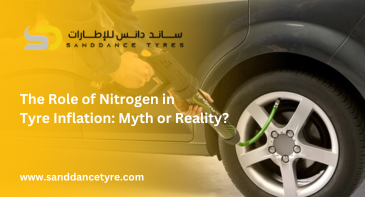
Home > We are here to provide 100% services to our customer The Role of Nitrogen in Tyre Inflation: Myth or Reality? The correct inflation pressure of tyres remains the base foundation for safety performance and fuel efficiency. The performance benefits of inert gas (nitrogen) outweigh compressed air as people prefer to use it for tyre inflation. Nitrogen delivers three essential advantages that include pressure control capabilities with temperature resilience and it improves tyre longevity. Should we consider nitrogen inflation superior to regular air inflation or is it merely a brand-induced belief? This discussion examines the scientific aspects involving nitrogen during tyre inflation processes. Understanding Nitrogen Inflation The inert quality of nitrogen while present as 78% of air’s content keeps it dry. The process of tyre inflation with gas serves as an oxygen-free and moisture-free additive which stabilizes tire pressure while reducing overall tire wear. The argument surrounding nitrogen vs air usage for tyre inflation becomes clear through an evaluation of their performance effects on tyres. Benefits of Nitrogen in Tyre Inflation 1. Enhanced Pressure Stability Nitrogen inflation provides strong pressure stability to tyre pressure because it preserves constancy in tire pressure across extended periods. The larger size of molecules in comparison to compressed air causes the rubber to block their passage so pressure retention becomes longer. 2. Improved Temperature Resistance Driving conditions produce heat which makes tyres warmer especially when vehicles travel at fast speeds. Tyres filled with air rather than gas experience enlarged pressure changes because excessive heat causes water vapour inside to enlarge. 3. Prolonged Tyre Lifespan Modern air includes both oxygen and moisture elements that can trigger oxidation deterioration of tyre linings inside a tyre. The absence of moisture in inert gas protects steel belts from rusting and prevents rim corrosion which extends the life of tyres. 4. Better Fuel Efficiency Proper tyre pressure level control decreases rolling drag which improves automotive fuel efficiency as a result. The force of friction rises when tyres remain underinflated and this raises fuel costs. With gas inflation, tyres retain proper pressure for longer, contributing to better mileage. 5. Advantages in Racing Applications The slightest modification in tyre pressure during motorsports racing will directly affect vehicle performance. Racing teams tend to choose gas inflation because it offers stable pressure control alongside temperature resistance which results in superior grip performance during demanding conditions. Protect your safety and performance quality by investing in high-end tyres from Sand Dance Tyre. Experience smooth driving without worries. Nitrogen vs Regular Air: Is It Worth It? Every driver might find advantages from nitrogen inflation in their vehicle but the necessity of this procedure remains unclear. Here’s a comparison: Feature Nitrogen Regular Air Pressure Retention High Moderate Moisture Content Low High Temperature Resistance High Moderate Tyre Longevity Longer Shorter Cost High Lower The regular maintenance of correct tyre pressure through inspection checks works effectively for both typical street commuters and infrequent drivers. Performance-driven drivers along with fleet operators and residents in extreme conditions may find nitrogen inflation to be a valuable purchase. How to Get Nitrogen Inflation for Your Tyres The professional nitrogen tyre-filling services of Sand Dance Tyre are available for customers in Dubai who want to switch to gas inflation. We will check your tyre pressure properly and help you reach maximum performance levels as well as extend your tyre’s lifespan. Looking for the best tyres for your vehicle? Explore our premium selection of off-road and highway tyres at Sand Dance Tyre today! Final Thoughts The value of nitrogen inflation relies on your driving habits because it provides distinct benefits such as stable pressure control along with resistance to temperature changes and extended tyre life duration. Nitrogen provides excellent performance stability while extending the lifespan of your tyres for people who focus on these two factors. The expert nitrogen inflation services at Sand Dance Tyre help customers maximize their tyre performance. Frequently Asked Questions – FAQs Can I mix nitrogen with regular air in my tyres? Adding regular air to a gas-filled tyre is possible but it reduces the beneficial effects of nitrogen usage. The best results from performance standpoints occur when you refill your tyre with pure nitrogen. How often should I check nitrogen-filled tyres? Regular pressure checks are essential once monthly to maintain optimal automotive performance even though the use of gas reduces tire pressure loss. Is nitrogen inflation only for high-performance cars? All types of vehicles including passenger cars, truck vehicles, and commercial fleets gain advantages from gas inflation.
The Connection Between Tyres & Suspension Performance
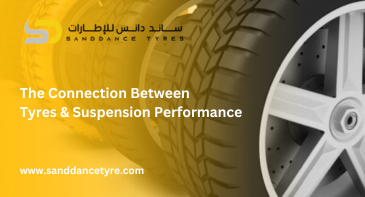
Home > We are here to provide 100% services to our customer The Connection Between Tyres & Suspension Performance Safety together with smooth driving performance depends crucially on the proper functioning of tyres & suspension. Such paired elements function in unison to improve vehicle handling and increase shock absorption as well as maintain wheel balance. The connection between tyres & suspension needs full comprehension by car owners who want to achieve better driving quality and road safety. This blog will discuss the connection between tyres & suspension systems and point out the value of appropriate maintenance along with recommendations for maximizing ride comfort and handling precision. How Tyres Influence Suspension Performance Your vehicle establishes its primary linkage with the surface through its tyre structures. A car’s suspension system together with shock absorption and ride quality heavily depends on the quality along with the type and condition of your tyres. Here’s how: 1. Shock Absorption and Road Bumps The first protective barrier for automobiles against road surface irregularities comes from tyres. The correct pressure level in premium tyres helps absorb major road bumps and decreases the stress applied to the suspension system. Worn-out or underinflated tyres require your suspension to function harder thus accelerating its deterioration. 2. Wheel Balance and Alignment The suspension parts sustain extra stress whenever tyres wear evenly or the wheel balance remains off. Tyres become unbalanced thus creating instability for the suspension because the vehicle cannot properly handle precision and suffers reduced comfort during rides. 3. Tyre Tread and Grip The specific pattern of tire treads together with their grip ability determines how well your vehicle handles different road situations. Defective tyres combined with poor traction affect the suspension system by making it difficult to maintain vehicle control when turning sharply or braking suddenly. How Suspension Affects Tyre Longevity The way a vehicle’s tyres perform affects suspension functions while suspension control also affects tyre operation. A properly maintained suspension system makes tyres perform better by distributing pressure evenly across all surfaces which extends their usage life. 1. Shock Absorbers and Struts Shock absorbers together with struts enable your vehicle to distribute weight equally between all four tyres. The wear pattern endures at specific areas when these components become damaged which results in continuous replacement of tyres. 2. Springs and Bushings Your suspension system maintains contact with the road surface through its springs and bushings to support your tyres correctly. Defected suspension parts create unbalanced weight distribution thus producing a rough driving experience as well as faster tyre breakdown. 3. Steering and Handling Stability Your vehicle’s steering response suffers from insufficient maintenance of your suspension system. The correct stiffness or softness of a suspension system is essential because improper levels will increase tire stress thus reducing their operational life while endangering driver safety. Don’t compromise on safety and comfort. Visit Sand Dance Tyre to find the best tyres in Dubai and enjoy a smoother, safer ride. Signs of Tyre & Suspension Problems Vehicle owners should inspect these indicators to maintain peak performance. Uneven tyre wear – Indicates alignment or suspension issues. Excessive bouncing or dipping – Suggests worn-out shock absorbers. Steering instability – Failure of suspension components typically generates this warning sign. Vibrations while driving – Unbalanced wheels or suspension wear might be responsible for vibrations. Strange noises when driving over bumps – Sign of damaged bushings or struts. Tips to Optimize Tyre & Suspension Performance Both the tyres & suspension must be in good condition for comfortable and safe driving. Here are some expert tips: Choose High-Quality Tyres – Get high-quality tyres for better shock dampening and grip retention. Regularly Check Tyre Pressure – Correct air pressure improves comfort and control of the vehicle. Perform Wheel Alignments & Balancing – Improves suspension control while reducing negative camber, resulting in less uneven tyre wear. Inspect Suspension Components – Make periodic inspections of struts, shock absorbers, and bushings for signs of wear. Drive Carefully Over Bumps – Steer clear of rough roads and potholes to reduce wear and tear on suspension and tyres. At Sand Dance Tyre, we offer high-quality tyres that enhance suspension performance and ride comfort. Visit our website to browse our collection and buy tyres online in UAE. Final Thoughts Understanding the relationship between tyres and suspension can help you maintain a comfortable and safe driving experience. By choosing the right tyres, keeping them properly maintained, and ensuring a well-functioning suspension system, you can enhance your vehicle’s performance and longevity. For top-quality tyres that support shock absorption, wheel balance, and handling precision, visit Sand Dance Tyre today! Frequently Asked Questions (FAQs) How often should I check my tyres and suspension? You should check your tyre pressure monthly and inspect suspension components during standard maintenance service which happens either every 10,000 km or per manufacturer guidelines. Can bad suspension damage my tyres? Defective suspension system components activate uneven tyre wear that decreases their operational life while putting safety at risk. What are the best tyres for shock absorption? Strong sidewalls with deep treads help radial high-performance tyres to deliver both superior shock absorption and desired ride comfort.
Eco-Friendly Tyres: Are They Worth the Investment?
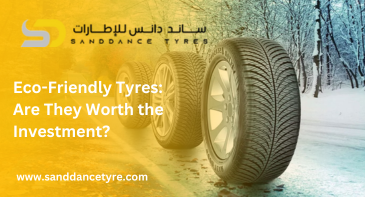
Home > We are here to provide 100% services to our customer Eco-Friendly Tyres: Are They Worth the Investment? In recent years, the demand for eco-friendly tyres has been on the rise, driven by growing environmental awareness and stricter sustainability regulations. As the world moves towards greener solutions, vehicle owners are exploring whether these tyres are a worthwhile investment. In this blog, we will delve into the benefits, costs, and environmental impact of eco-friendly tyres, helping you decide if they are the right choice for your vehicle. What Are Eco-Friendly Tyres? Eco-friendly tyres are designed to minimize environmental impact by reducing fuel consumption, lowering carbon emissions, and utilizing sustainable materials in their construction. Unlike conventional tyres, which rely heavily on petroleum-based rubber and synthetic compounds, these tyres incorporate renewable resources such as natural rubber, silica-based compounds, and biodegradable materials. The Benefits of Eco-Friendly Tyres 1. Reduced Fuel Consumption and Cost Savings One of the major benefits of eco-friendly tyres is their low rolling resistance, which means they require less energy to move. This results in improved fuel efficiency, allowing you to save money on fuel costs in the long run. Studies show that vehicles equipped with eco-friendly tyres can experience up to a 10% improvement in fuel economy. 2. Lower Carbon Footprint Traditional tyres contribute significantly to carbon emissions due to the energy-intensive manufacturing process and increased fuel consumption. Eco-friendly tyres, on the other hand, help reduce greenhouse gas emissions, making them a more sustainable choice for environmentally conscious drivers. 3. Durability and Longevity Manufacturers design eco-friendly tyres with high-quality compounds that enhance their durability. These tyres tend to last longer than conventional tyres, leading to fewer replacements and reduced waste in landfills. Over time, this adds to both cost savings and sustainability. 4. Better Road Performance Many people assume that eco-friendly tyres compromise performance, but that’s not the case. These tyres offer excellent grip and handling, ensuring safety on wet and dry roads. The use of silica in the tread compound enhances traction while keeping wear and tear minimal. 5. Noise Reduction Eco-friendly tyres often feature advanced tread designs that help in noise reduction, creating a quieter and more comfortable driving experience. Are Eco-Friendly Tyres Worth the Cost? One of the biggest concerns for vehicle owners is the cost of eco-friendly tyres compared to conventional options. Initially, these tyres may seem more expensive, but they offer significant long-term savings due to: Lower fuel consumption Extended lifespan Reduced maintenance and replacement costs When considering these factors, eco-friendly tyres become a cost-effective investment over time. Environmental Impact of Eco-Friendly Tyres The production and disposal of conventional tyres pose severe environmental challenges. Every year, millions of tyres end up in landfills, taking decades to decompose. Eco-friendly tyres address these concerns by: Using sustainable materials to reduce dependency on fossil fuels. Enhancing recyclability, making them easier to repurpose after use. Lowering emissions through energy-efficient manufacturing processes. By choosing eco-friendly tyres, you contribute to a cleaner environment and support the global movement towards sustainability. How to Choose the Right Eco-Friendly Tyres If you’re considering making the switch, here are some tips to ensure you select the best eco-friendly tyres for your vehicle: Check the Label – Look for tyres with the EU Tyre Label, which provides information on fuel efficiency, wet grip performance, and noise levels. Look for Reputable Brands – Brands like Michelin, Bridgestone, and Goodyear offer high-quality eco-friendly tyre options. Assess Your Driving Needs – Consider the climate, terrain, and your driving habits before making a purchase. Compare Costs and Reviews – Read customer feedback and compare prices to find the best balance between cost and quality. Final Verdict: Should You Invest in Eco-Friendly Tyres? For those prioritizing sustainability, fuel savings, and long-term durability, eco-friendly tyres are a smart investment. While the initial cost might be higher, the overall benefits—including reduced fuel consumption, lower emissions, and improved performance—make them a worthwhile choice for both the environment and your wallet. If you’re ready to upgrade to eco-friendly tyres, visit Sand Dance Tyre Shop for a wide range of sustainable tyre options tailored to your needs. Get in touch today and drive towards a greener future! FAQs 1. Are eco-friendly tyres more expensive? Yes, eco-friendly tyres typically have a higher upfront cost, but they offer long-term savings through better fuel efficiency and extended lifespan. 2. Do eco-friendly tyres perform well in extreme weather conditions? Many eco-friendly tyres are designed for all-weather performance, providing good grip and durability in both wet and dry conditions. 3. Can eco-friendly tyres be recycled? Yes, most eco-friendly tyres are recyclable and made from materials that can be repurposed, reducing landfill waste. 4. How do I know if a tyre is truly eco-friendly? Look for certifications and labels such as the EU Tyre Label or Sustainable Manufacturing Badges to ensure the tyre meets environmental standards. 5. Where can I buy eco-friendly tyres in Dubai? You can purchase high-quality eco-friendly tyres at Sand Dance Tyre, where we offer expert guidance and a range of sustainable options. Visit us today and make the switch to eco-friendly driving!


